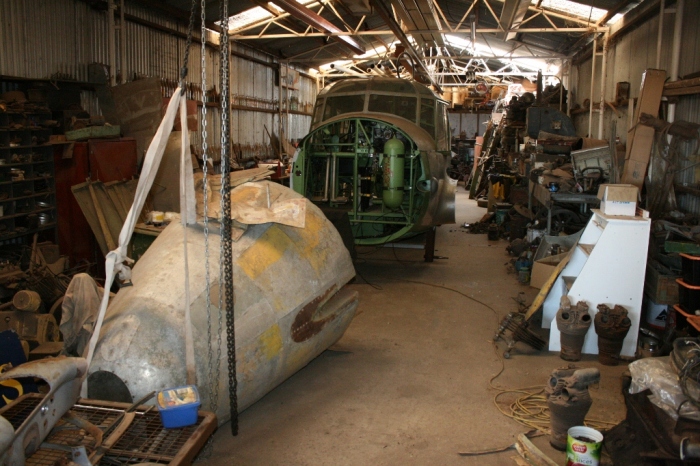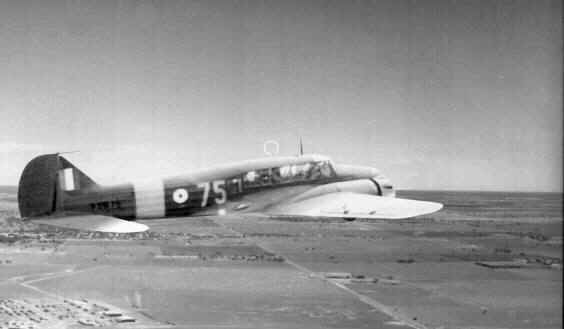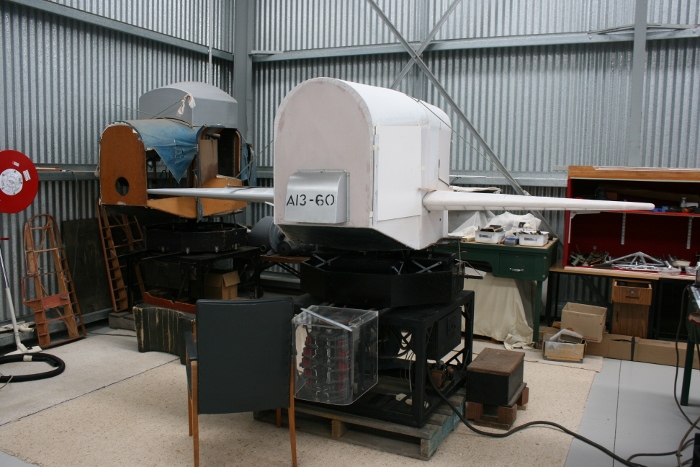In March 2013 I shared the progress of a grass-roots community based Avro Anson restoration project being completed by the Nhill Aviation Heritage Centre in Nhill, a small town in country Victoria, Australia (in the Wimmera region, not far from the towns where I grew up). This particular World War Two era, British designed Avro Anson Mk.I (serial number W2364) was a former Royal Australian Air Force (RAAF) twin-engined maritime patrol, air crew training and liaison aircraft built in 1941 and operated in these various roles and then as an instructional airframe, until sold as surplus in 1953.

This was a restoration project being conducted in the home workshops of various contributors around the town (one for the airframe, one for the engines and another for the tail plane – I visited these workshops in December 2012 and February 2013 to get a first hand look at the restoration progress) with the aim of completing an aircraft that could be taxied but not flown. Back then they were making amazing progress on something that had only started a few short years before with the recovery of what was a what was virtually an Avro Anson airframe wreck from a Wimmera farm in 2009.

Since retirement from RAAF service the aircraft had been taken apart for metal components to be used for farming purposes and left out in the open for almost 60 years. Exposure to the elements had left the fabric covered steel tube fuselage frame in very poor condition and the wooden wings had long since disappeared. 3.5 metres of the rear of the Anson was actually missing! As such a new rear section of the aircraft had to be rebuilt for the restoration project. The engines had been left out there for all those years too and were also in a bad state.
In early 2013 the restoration project was around 50% complete and the Anson was starting to look like its former self. Fast forward to 2015 and so much has happened. I have just revisited this project (late September 2015) and I am happy to report that the restoration is well advanced and the Anson is looking fantastic! There is still a long way to go but all is looking very good.

New Museum Facility
In May 2014 the new Ahrens Hangar was opened at the Nhill Aerodrome to become a museum to house the Avro Anson, along with the associated memorabilia and parts they have collected over the years associated with the aircraft and the aerodrome (currently the museum is open on weekends and public holidays excluding Christmas Day and Good Friday). The Nhill Aerodrome was a former RAAF Empire Air Training Scheme air base in World War Two and home to RAAF No. 2 Air Navigation School, No. 1 Operation Training Unit, No. 97 Squadron Reserve and the Air Armament and Gas School. The base operated from 1941-1946 predominately flying the Avro Anson to conduct air navigation and armaments training, including bombing training which was completed over the nearby Little Desert (a National Park since 1968). 10,000 men and women trained at Nhill during World War Two.



This local link to the Anson made Nhill a perfect place to restore the aircraft and create a local tourist destination to keep the memory alive of the important role the aircraft, this town and the RAAF personnel trained there, played in the Allied victory during World War Two. The museum and aircraft will also become a tribute to the men and women who served there.
Anson Restoration Progress
With the completion of the new museum the Anson airframe could be relocated and have the inner wings, engine frames, undercarriage, tail plane and one of the restored Armstrong-Siddeley Cheetah Mk.IX seven-cylinder radial engines fitted to the starboard inner wing (the other engine is still being restored and rebuilt). All this has been completed by the Nhill Aviation Heritage Centre in just 5 years with the full support of the local Hindmarsh Shire who own the Nhill Aerodrome!
I have recently visited the heritage centre facility for a close up look at the Anson and the new hangar and the progress in the airframe restoration from my 2013 photos to the 2015 photos is very evident with the nose cone, panels, bomb doors and many additional components now fitted, replaced or restored. The wooden wings of this model of Avro Anson still need to be built, as no surviving parts were available to be recovered with the original airframe (I cannot wait to see this part of the project completed).







The interior cockpit and crew compartment restoration has also come a long way since December 2012. Changes were evident with the cockpit control panel, navigation and radio desks and equipment mostly fitted along with the bombardier/navigation position in the nose. Plus further floor panelling and structural components.




The fitted Cheetah radial engine was successfully fired up and briefly run for the first time on September 13th, 2014. A month later the engine was successfully run again for 25 minutes.




Thousands of hours of volunteer work and dedication is paying off (a big effort very well done). Restoration Manager Mick Kingwell has been primarily responsible for putting in an immense amount of work on the airframe, along with Wimpey Reichelt’s restoration of the Cheetah engines and Len Creek’s rebuilding of the tail plane (plus help from others on various stages of the restoration).

Link Trainer Restoration
Since my last visit the restoration team are also working on the restoration of two Link Trainers (A13-54 and A13-60 – one is for the owner of the Link Trainers and the other he has donated to the museum in lieu of the restoration work). Link Trainers were an early flight instrument and flight dynamics training simulator produced during the 1930’s through to the 1950’s by Link Aviation Devices Inc. in New York (the Link Trainer was first developed in 1929). They were a key pilot training component in World War Two for most Allied nations including Australia.

The Link Trainer restoration project is also a big job, as time and weather exposure has taken its toll on both examples, as well as their associated instructor tables and equipment (internal corrosion from moisture ingress was particularly an issue). Some of the associated equipment and components have also proven to be unrepairable or beyond restoration and need to be replaced including the fabric covering the trainer. Neil Thomas is responsible for the principle restoration of the Link Trainers and has made fantastic progress on A13-60 to date.




Thankyou!
Many thanks to John Deckert (Nhill Aviation Heritage Centre board member) for providing me the opportunity to once again get “behind the scenes” and granting access to take a close look at the progress of this restoration project (also a big thanks to his extended family for their hospitality during my visit to Nhill). It was also a pleasure to meet Rob Lynch (Nhill Aviation Heritage Centre President) to discuss the history of the Nhill Aerodrome and the restoration project, along with Neil Thomas to get some perspective on his dedicated work to restore the Link Trainers.

NAHC Membership & the Nhill Airshow
If you would like to contribute to the cause and help fund the Anson restoration please take a look at the Nhill Aviation Heritage Centre website for information on how to become a NAHC Member. Your support will be greatly welcomed I am sure.
Also if you are in the region don’t miss the Nhill Airshow on October 10th, 2015 as they have a great air and ground program planned. The flying displays will include the RAAF Roulettes display team, a CAC Boomerang, Curtiss P-40 Kittyhawk and North American P-51D Mustang, plus much more including Douglas DC-3 flights. Sounds great to me!


Reblogged this on Travel for Aircraft and commented:
A wonderful summary of the Anson as well as reporting on the famous recent Anson restoration — plus a bonus 🙂
LikeLiked by 1 person
Thanks Joe!
LikeLike
Funny we should all chose to talk about restorations at the same time. I mentioned the Memphi Belle getting her control panel back and IHRA sent me the link for ‘Doc,’ which is still raising money.
LikeLiked by 1 person
Great to get all this info out there. I saw the Memphis Belle back in the 1990’s on Mud Island in Memphis, TN. I am glad it is back in the hands of the USAF and getting fully restored
LikeLiked by 1 person
Can you imagine someone having the control panel and using it as a coffee table?!!!
LikeLike
Kind of ridiculous isn’t it?
LikeLiked by 1 person
Oops, hit the wrong button and never got in what a great post you compiled here today!!!
LikeLiked by 1 person
Thankyou. Must have been the day for restoration news! Great to see so many old birds coming back together!
LikeLiked by 1 person
A great job they have done with what was basically scrap!
LikeLiked by 1 person
They’re doing an amazing job restoring that Annie.
LikeLiked by 1 person
Yes it is coming along so well
LikeLiked by 1 person
A largely unsung but very essential aircraft to the war effort.
LikeLike
Another early WW2 type back from the dead, so to speak! I recently saw the Blenheim (a Bolingbroke conversion) fly at Duxford in its Battle of Britain era Mk If form. That conversion relied on the acquisition of the ONLY Mk I nose still in existence (from the Bristol area of the U.K.) which had been converted for use as a ‘light car’!
.
LikeLike
It is amazing what people used the parts for. In Australia there used to be a houseboat made from a Dornier flying boat and another from a Catalina! Both saved from that fate now
LikeLiked by 1 person
Thank You for your speedy response Deano & please accept my apologies for my confusion between the KIWI & this AUS project. Are the photos attached to this Anson Wing Blog for the KIWI or AUS project ? If I am correct this time, & this is for the AUS project, there are 2 photos which clearly show the A.W.11 Turret I am trying to model. The first photo, comparing progress from 2012 to 2015, shows the Anson (nose-on with a Coca-Cola sign to the left on the wall) & the turret in yellow is visible at the rear of the workshop/hangar. The second photo, entitled “Remnants of the Anson’s RAAF past”, again clearly shows the turret in yellow on a bench. Am I correct in assuming that this turret will not be used in this particular restoration project ? If so, would there be anyone that you know of that I can contact to request their services in providing photos & dimensional line drawings of this turret. I have been searching for the last 4 years to obtain a series of dimensional drawings that would permit the creation of CAD drawing (photos & line drawings of this turret as follows: “FWD gun slot aperture”, “AFT armour plate section”, “LHS”, “RHS”, “Looking UP from the bottom”, & Looking DN from the top, plus close-ups of “Seat Hinge Points”, “UPR Vanes”, & the “Sliding Tube/Channel connections” for the Clear Rydoine Panels which operate in conjunction with gun movement.
Thank You in advance for any assistance or guidance you can provide at this time.
Alan.
LikeLike
Hi Alan, my understanding is that the turret will be restored and fitted on the Aus Anson. Your best bet would be to email The Nhill Aviation Heritage Centre directly and they may be able to help you out with the schematics etc. nhillairshow@gmail.com
LikeLike
Sorry about the misspelled panel nomenclature … “RHODOID Panels” is the correct terminology !
LikeLiked by 1 person
i got parts for the EG535 which i already restored.
if you are looking for the noses wire hook thing i got it.
its like that big pole on the roof but smaller.
LikeLiked by 1 person
Hi Bryce, I am not directly involved with the project but I am sure they would be interested in hearing from you – admin@nhillaviationheritagecentre.com.au
LikeLike
[…] to enable it to be taxied but not flown. Steady progress has continued on the Anson since my 2015 and 2016 updates on the restoration […]
LikeLike
[…] 2015 Update […]
LikeLike
[…] 2015 Update […]
LikeLike
[…] 2015 Update […]
LikeLike